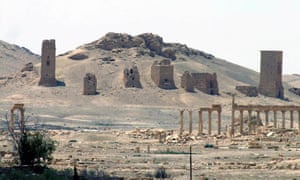
The brutal murder of Khaled al-Asaad, 82, is the latest atrocity perpetrated by the extremist jihadi group, which has captured a third of both Syria and neighbouring Iraq and declared a self-styled “caliphate” on the territory it controls. It has also highlighted Isis’s habit of looting and selling antiquities to fund its activities - as well as destroying them.
Asaad had been held for over a month before being murdered. Chris Doyle, director of the Council for Arab-British Understanding, said he had learned from a Syrian source that the archaeologist had been interrogated by Isis about the location of treasures from Palmyra and had been executed when he refused to cooperate.
Isis captured the city from government forces in May but is not known to have damaged its monumental Roman-era ruins despite a reputation for destroying artefacts they view as idolatrous.
“Just imagine that such a scholar who gave such memorable services to the place and to history would be beheaded ... and his corpse still hanging from one of the ancient columns in the centre of a square in Palmyra,” Abdulkarim said. “The continued presence of these criminals in this city is a curse and bad omen on (Palmyra) and every column and every archaeological piece in it.”
Palmyra-based activists circulated an unverified, gruesome image on social media of Asaad’s beheaded body, tied to a pole on a street in the city.
A board in front of the body set out the charges against him, which accused him of loyalty to the Syrian president, Bashar al-Assad, maintaining contact with senior regime intelligence and security officials and managing Palmyra’s collection of “idols.”
Isis, which follows a puritanical interpretation of Islam, considers maintaining such ancient statues to be apostasy.
According to Syrian state news agency Sana and the UK-based Syrian Observatory for Human Rights, Asaad was beheaded in front of dozens of people on Tuesday in a square outside the town’s museum.
His body was then taken to Palmyra’s archaeological site and hung from one of the Roman columns.
Abdulkarim said Asaad was known for several scholarly works published in international archaeological journals on Palmyra, which in antiquity flourished as an important trading hub along the Silk Road. He was a scholar of Aramaic, the lingua franca of the area before the rise of Islam in the 7th century.

The Sana news agency said he had discovered several ancient cemeteries, caves and a Byzantine cemetery in the garden of the Palmyra museum.
“Al-Asaad was a treasure for Syria and the world,” his son-in-law, Khalil Hariri, told the Associated Press. “Why did they kill him?”
“Their systematic campaign seeks to take us back into pre-history. But they will not succeed.”
Before the city’s capture by Isis, Syrian officials said they moved hundreds of ancient statues to safe locations out of concern they would be destroyed by the militants. Isis is likely to be looking for portable, easily saleable items that are not registered, Doyle said.
In June, Isis did blow up two ancient shrines in Palmyra that were not part of its Roman-era structures but which the militants regarded as pagan and sacrilegious. In early July it released a video showing the killing of 25 captured government soldiers in the Roman amphitheatre.
Unesco warned last month that looting has been taking place on an “industrial scale.” Isis advertises its destruction of sites such as Nimrud in Iraq but says little about the way plundered antiquities help finance its activities. Stolen artefacts make up a significant stream of the group’s estimated multi-million dollar revenues, along with oil sales and straightforward taxation and extortion.
Archaeological experts say Isis took over the already existing practice of illegal excavation and looting which until 2014 was carried out by various armed groups, or individuals, or the Syrian regime.
Isis initially levied 20% taxes on those it “licensed” to excavate but later began to hire their own own archaeologists, digging teams and machinery. The group invested more when the US-led coalition began to bomb oil fields and other targets and enforced punishments for looting without a licence.






































No comments:
Post a Comment